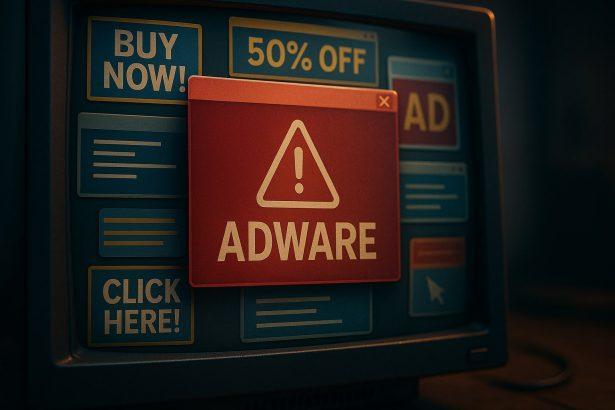Warning: loboodae.com can trick you into allowing deceptive browser notifications. If you click “Allow” on the wrong prompt, your system could be exposed to scam sites, adware, or even malware.
Ads by loboodae.com is a browser-based threat that abuses your notification permissions. It typically appears after visiting a suspicious site and shows a fake prompt like “Click Allow to confirm you’re not a robot.” Once you click, it hijacks your browser’s push-notification system to send endless pop-up ads promoting scams, fake downloads, or other risky content.
Threat Summary
| Category | Details |
|---|---|
| Threat Type | Push‑notification ads, intrusive pop‑ups, unwanted ads |
| Associated Domains/IP | sitemaps.loboodae.com, kafka-ui.loboodae.com; IP: 108.62.157.37 |
| Symptoms | Ads appearing without consent; persistent pop-ups; browser slowdowns |
| Distribution Methods | Deceptive notification prompts; redirects via ad networks; adware |
| Damage | Reduced performance; tracking and privacy violations; potential malware |
| Danger Level | Moderate to high—due to privacy breach and potential downstream threats |
What Are Ads by loboodae.com & How Did I Get Infected?
Ads by loboodae.com isn’t technically malware, but a rogue domain used to manipulate browser notifications. You’re most likely to see it after visiting a high-risk site, getting redirected by a shady ad, or clicking on a fake streaming or CAPTCHA page. If you hit “Allow” on the prompt, you’ve unknowingly permitted constant ad delivery to your device.
What Ads by loboodae.com Does to Your Browser
Once you accept notifications from loboodae.com, the site abuses that permission to flood your device with pop-ups. These ads may lead to phishing pages, tech support scams, fake download sites, and even malware-infected files. They can show up while you’re browsing other sites or even when your browser is closed.
Should You Be Worried About Ads by loboodae.com?
Absolutely. While the domain itself doesn’t install viruses, it serves as a springboard for far more dangerous threats. Some of the ads it pushes can trick users into downloading malicious software, entering sensitive data into fake forms, or calling fraudulent tech support numbers. Left unchecked, this can lead to compromised accounts, malware infections, or financial loss.
Manual Adware Removal Process (Windows & Mac)
Step 1: Identify and Uninstall Suspicious Applications
For Windows Users
- Open Task Manager by pressing
Ctrl + Shift + Esc. - Navigate to the “Processes” tab and search for unknown or high-resource-consuming processes.
- If you detect anything suspicious, right-click and select “End Task.”
- Go to
Control Panel>Programs>Programs and Features. - Locate and uninstall any unfamiliar programs.
For Mac Users
- Open
Finderand click onApplications. - Identify and move any suspicious applications to the
Trash. - Empty the
Trash. - Check
System Preferences>Users & Groups>Login Itemsfor unknown startup programs and remove them.
Step 2: Remove Malicious Browser Extensions
Google Chrome
- Open Chrome, click
Menu(three dots) >Extensions. - Locate and remove unknown extensions.
- Reset Chrome:
Settings>Reset settings> “Restore settings to their original defaults.”
Mozilla Firefox
- Click
Menu>Add-ons and themes. - Remove suspicious extensions.
- Reset Firefox:
Help>More troubleshooting information> “Refresh Firefox.”
Safari (Mac)
- Open Safari, go to
Preferences>Extensions. - Delete unknown extensions.
- Reset Safari:
History> “Clear History.”
Microsoft Edge
- Click
Menu>Extensions. - Remove any unfamiliar extensions.
- Reset Edge:
Settings>Reset settings> “Restore settings to their default values.”
Step 3: Delete Adware-Associated Files and Folders
For Windows Users
- Press
Win + R, type%AppData%, and press Enter. - Locate and delete suspicious folders.
- Repeat for
%LocalAppData%,%ProgramData%, and%Temp%.
For Mac Users
- Open Finder and press
Shift + Command + G, then enter~/Library/Application Support/. - Remove any suspicious folders.
- Repeat for
~/Library/LaunchAgents/,~/Library/LaunchDaemons/, and~/Library/Preferences/.
Step 4: Flush DNS Cache to Remove Adware Traces
For Windows Users
- Open
Command Promptas Administrator. - Type
ipconfig /flushdnsand press Enter.
For Mac Users
- Open
Terminal. - Enter
sudo killall -HUP mDNSResponderand press Enter.
Step 5: Restart Your System
Perform a reboot to apply the changes and ensure the removal process is complete.
Automatic Adware Removal Using SpyHunter (Windows & Mac)
For an effortless and effective solution, use SpyHunter, a powerful anti-malware tool designed to detect and remove adware completely.
Step 1: Download SpyHunter
Click the link to download SpyHunter: Download SpyHunter Here.
Step 2: Install SpyHunter
Follow the installation guide based on your operating system:
For Windows Users
- Run the downloaded
.exefile. - Follow the installation instructions.
- Launch SpyHunter and allow it to update its malware database.
For Mac Users
- Open the downloaded
.dmgfile. - Drag and drop SpyHunter into
Applications. - Open SpyHunter and let it update its database.
Step 3: Scan and Remove Adware
- Open SpyHunter.
- Click
Start Scan. - Wait for the scan to complete.
- Click
Fix Threatsto remove detected malware.
Step 4: Restart Your Computer
After SpyHunter removes all threats, restart your system to ensure all adware components are fully removed.
Conclusion
loboodae.com isn’t just a nuisance—it’s a manipulative site that opens the door to aggressive advertising, scams, and possibly malware. Removing its notification permissions is essential for protecting your device, your data, and your time. Once removed, consider scanning your system for other threats or adware that may have come bundled along the way.




